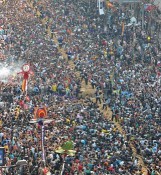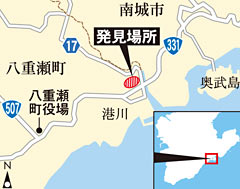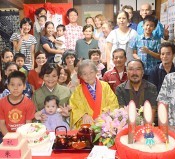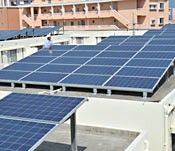Top News

October 10, 2012 Ryukyu Shimpo
On October 9, Okinawa Governor Hirokazu Nakaima and Ginowan Mayor Atsushi Sakima met with Prime Minister Yoshihiko Noda and Chief Cabinet Secretary Osamu Fujimura at the Prime Minister’s Office. During their meeting, the governor and mayor handed over a written statement to the ministers requesting that the central government review the deployment of the MV-22 Osprey to Okinawa.
Noda indicated that the government does not intend to withdraw the MV-22s, but said that they will push for the transfer of some of the Osprey training to locations outside of Okinawa, and requested the understanding of the people of Okinawa. This was the first time that the prime minister has met with the
Okinawa governor to discuss the deployment of the Osprey.
In addition, the governor asked the prime minister to ensure that the safety measures set up in the agreement decided upon by the governments of Japan and the United States are strictly adhered to, including the Osprey being limited to flying in the helicopter-mode only above the bases. Nakaima also requested the redistribution of the aircraft outside of Okinawa to bases across the country and demanded the relocation and early return of U.S. Marine Corps Air Station Futenma.
After meeting with Prime Minister Noda, the governor and mayor met with Chief Cabinet Secretary Osamu Fujimura, Defense Minister Satoshi Morimoto, Foreign Minister Koichiro Genba and Okinawa and Northern Territories Affairs Minister Shinji Tarutoko. In their meeting with Tarutoko at the Cabinet Office, Governor Nakaima asked him to secure the development budget for Okinawa at the end of the year.
In the meeting with the Okinawan governor Prime Minister Noda said, “The government takes the request of the Okinawan people and the citizens of Ginowan seriously.” He also said, “I will request that the U.S. government adheres to the safety measures that have been decided upon and I will follow up on this. In addition, I will strengthen efforts to reduce the burden on the Okinawan people and carry out measures to promote the development of Okinawa, including the early relocation of the facilities at Futenma and the return of land currently used by the bases. I would like to ask that the Okinawan people show understanding towards government policies.”
Nakaima said, “The Okinawan people’s opposition to the deployment of the Osprey has increased to a level greater than before the aircraft was deployed.” He requested that the Prime Minister continue to remind U.S. forces to comply with the bilateral agreement. When he read the statement, Sakima called for the swift withdrawal of the Osprey as well as for the urgent closure of Futenma Air Station and the return of the land that it occupies.
After the meeting, the governor told reporters, “I strongly urged the government to review the deployment of the Osprey. I want them to consider deploying the Osprey in locations throughout the country.” In the meeting with the ministers, the governor said, “The national budget will be set in difficult times. However, I asked them to commit to securing budget for the development of Okinawa next year.”
The mayor told reporters, “It was a valuable opportunity to state our views to Prime Minister Noda. However, he did not say that the government would reconsider the deployment of the Osprey.”
(English translation by T&CT, Mark Ealey)
Go to Japanese

October 3, 2012 Ryukyu Shimpo
As part of an ongoing business model project, the Naha Port Authority will start a pilot program to export used cars to Africa. The project has been carried out previously with Taiwan in order to establish a logistics business model.
On October 2, 2012 the council held its first meeting of the year in the passenger area of Naha Wharf.
The Naha Port Authority already exports less-than-container load cargos to Hong Kong and Taiwan. In fiscal 2011, cargo was sent using containers to Taiwan, but for this new project in fiscal 2012 they will evaluate potential freight routes from Okinawa to South-East Asia and Africa and ways to find car dealers in South-East Asia and Africa.
At the end of this month, mail-order company for automotive parts WorldWide & Company Pte. Ltd. will set up a limited liability company called Bankoku-shinryo-kai which will export used cars from Okinawa through a base of operations in Dubai. The company will then extend its exports to other countries in regions such as South-East Asia and Africa where there is a need for used cars.
During their first meeting of 2012, project staff announced that they have managed to cut transportation costs, but for the business model to be viable, shipments have to be increased and the transportation time must be reduced.
(English translation by T&CT, Lima Tokumori and Mark Ealey
Go to Japanese

October 8, 2012 Ryukyu Shimpo
On October 7, the 42nd Naha Ozunahiki (Naha Tug of War) was held at the intersection of Route 58 in Kumoji, Naha. According to the organizers, about 275000 people participated in the festival, enjoying the vibrant atmosphere of the event in which huge numbers of people pull on a giant straw rope 200 meters long and weighing 43 tons. The tug of war is between the East team (the male rope) and the West team (female rope) and is held over a maximum of 30 minutes. Loud cheers went up from the crowds of people lined up on the roadside. The West team won this year’s contest, generating a result for the first time in four years.
The Naha Tug of War is an annual traditional festival held to pray for happiness and peace. In his speech, Naha mayor Takeshi Onaga, who is the chairperson of the festival organizing committee, said, “I am deeply moved to see the Naha Ozunahiki this year that marks the 40th anniversary of Okinawa’s reversion to Japanese sovereignty. It has grown to become a citizens’ event that we can proudly show to the world.”
The total score through the years is 13 wins, 12 losses and 14 draws for the West team against the 12 wins, 13 losses and 14 draws for the East team.
(English translation by T&CT, Mark Ealey)
Go to Japanese

Go To Video
October 7, 2012 Ryukyu Shimpo
On October 6, the U.S. Marine Corps moved the remaining three MV-22 Ospreys that had been at U.S. Iwakuni Air Station to U.S. Marine Corps Air Station Futenma. The Marines have now completed the deployment to Okinawa of all of the 12 aircraft that had been at Iwakuni temporarily since July. The Corps will carry out MV-22 training in conjunction with marine infantry units based in Futenma. In addition, the Corps will send several aircraft to Camp Fuji, in Shizuoka Prefecture and to Iwakuni on a monthly basis, and will conduct training, including low-level flight training, in Honshu, Shikoku and Kyushu. On October 9, Okinawa Governor Hirokazu Nakaima met with Prime Minister Yoshihiko Noda to request the withdrawal of the Osprey from the prefecture.
According to the Okinawa Defense Bureau, the last three aircraft took off from Iwakuni Air Station one after another at 12:24pm on October 10, arriving at Futenma at before 3:00pm that afternoon. The three aircraft passed over urban areas when moving from Naha to Urasoe and then on to Ginowan. A reporter of the Ryukyu Shimpo witnessed one of the aircraft flying over Ginowan in helicopter-mode with the rotors facing upwards. In the Japan-US agreement governing the deployment of the Osprey, the aircraft are limited to using helicopter-mode only flying above bases. However, there is now growing concern in the prefecture about the effectiveness of the safety measures that the Japanese and U.S. governments have agreed upon.
On October 1, six aircraft arrived at Futenma, and on October 2 another three aircraft landed. The Marine Corps conducted flight training on two consecutive days from October 4. The Osprey have taken off and landed at bases in the central and northern parts of the main island of Okinawa and on the Ie Auxiliary Airfield.
The three aircraft that moved to Okinawa on October 6 were behind schedule in flying to Futenma because they needed parts to be replaced. The U.S. military is planning to deploy an additional 12 Osprey aircraft to Futenma by 2014.
Okinawa governor criticizes the government for going ahead with the Osprey deployment
On October 6, Governor Hirokazu Nakaima indicated his strong dissatisfaction with the two governments because the U.S. Marine Corps has deployed all 12 MV-22 Osprey vertical take-off and landing aircraft to Futenma Air Station. “We have no option but to protest to the government,” the governor told reporters in Naha. The agreement on the safe operation of the Osprey has become a dead letter. Nakaima said, “The governments have forced these aircraft on Okinawa despite the agreement surrounding them being useless. I think that the Osprey being pushed on us like this is a real problem.”
(English translation by T&CT, Mark Ealey)
Go to Japanese

Go To Video

September 26, 2012 Ryukyu Shimpo
On September 25, the Urasoe Commercial High School (UCHS) baseball team that took part in the national Koshien Summer Championship presented some “sacred soil” from the Koshien Stadium and a practice ball to Yo Teruya, a third-year student of the Okinawa Prefectural High School for Special-Needs Education. He is the first special-needs school student in Japan to take part in official games, which he did as a player of Okinawa Chubu Agricultural High School’s branch class.
Takamasa Miyara, the manager of the UCHS team, has worked at a special-needs school and his talking to Teruya was the beginning of exchange with UCHS. In early August, UCHS players gave Teruya their team uniform when he practiced with them and promised him to win their games at Koshien and bring him the soil.
On the same day, manager Miyara, captain Ryusuke Uchima and pitcher Taiyu Miyazato visited Chubu Agricultural High School in Uruma to give Teruya the soil from Koshien and a ball they used in practice during the national championship. Miyara smiled saying, “We were able to keep our promise.” Teruya said, “Every high school student who plays baseball dreams of playing at Koshien. I do too. I will treasure this soil.”
Miyara said, “I was moved that Teruya dreams of playing at Koshien despite being at a special-needs school. I hope that his efforts will encourage students who need special education.” Uchima said that he was glad to see Teruya smiling. Miyazato said that Teruya has always kept trying and that he respects him for this.
Teruya was fifth in the batting order and played left fielder in the prefectural elimination tournament to choose the team for Koshien this summer. His team lost, but is proud that he was able to play in the game. After the elimination games, he went to a club and helped to coach junior players. “It was good that I have kept playing baseball. After the game, I came to like it more than ever,” said Teruya with a smile.
(English translation by T&CT, Lima Tokumori and Mark Ealey)
Go to Japanese

October 4, 2012 Ryukyu Shimpo
In the morning of October 4, 245 people arrived at Naha Airport from Bangkok on a charter flight operated by Thai Airways International, the largest airline in Thailand. The Okinawa Convention & Visitors Bureau held a welcome ceremony for them in the international terminal. During their five-day and four-night visit, they will participate in the Naha Otsunahiki Festival (Naha Tug of war), which will be held on October 7, as well as visit popular tourist destinations such as the Okinawa Churaumi Aquarium and the Okinawa World Culture Kingdom Gyokusendo.
That same day, 208 tourists departed from Okinawa to Thailand. This interactive charter tour program was organized by Jumbo Tours, in Naha.
The charter flight to Okinawa operated by Thai Airways International is the second one this year and there are plans to conduct the same charter tours again next year. Katsumi Tanimura, the president of Jumbo Tours said, “We will continue to offer this tour program to contribute to Okinawan tourism. An economic impact of about 30 million yen is expected for Okinawa through this tour.”
(English translation by T&CT, Mark Ealey)
Go to Japanese

October 4, 2012 Ryukyu Shimpo
On October 3 a citizens’ rally protesting against the Osprey deployment was held in the courtyard of Nago Municipal Office. This was the first rally to be held at the level of a village, town or city since the Osprey were deployed in Okinawa and according to the organizers, more than 1000 people took part. The participants adopted a resolution calling for the withdrawal of the Osprey and the closure and removal of the U.S. military facilities at Futenma. Nago Mayor Susumu Inamine, who is the chairperson of the executive committee of the rally, said, “I want to ask the Okinawan people to join us to create an even more powerful message to ensure that the governments of Japan and the United States listen to what we have to say.”
Yoshikazu Tamaki, a member of the Okinawa Prefectural Assembly and secretary-general of the Okinawan People’s Rally held on September 9, stated that they were considering taking action and were collecting signatures to call for a prefectural referendum in an attempt to overturn the Osprey deployment. On October 4, Mayor Inamine and other organizers of the rally visited the Okinawa Defense Bureau and the Naha Office of the Ministry of Foreign Affairs to hand over the resolution. They also hope to present the resolution to government officials attending the meeting to be held in Tokyo from October 15 to 17 between members of the Okinawa Municipal Council for Military Land Conversion and Base Problems and government officials.
A rally was held in Yaese Town on October 4, and another is planned for October 16 in Ogimi Village, indicating that the opposition to the Osprey deployment is now widespread across Okinawa. In his speech, Mayor Inamine criticized the governments of Japan and the United States, saying that, “In return for gaining independence, Japan cut Okinawa adrift in the San Francisco Peace Treaty by placing it under U.S. military occupation. That structural discrimination against Okinawa remains, and is reflected in the current controversy.” He called for further protest rallies by the other municipalities, saying “We should initiate a wave of protest action against the governments of the Japan and the United States. We simply cannot accept the Osprey and will do our best to get it out of Okinawa.”
After the rally, Inamine told reporters, “The V-shaped runways planned for the Futenma Relocation Facilities in Henoko are designed to match the Osprey performance specifications. The Futenma to Henoko relocation plan will be irreversible if we cannot stop the deployment of the Osprey.”
In addition to Inamine and Tamaki, representatives from various organizations gave speeches. Some members of the opposition party of the Nago Municipal Assembly who had been on Osprey at Iwakuni Air Station in Yamaguchi Prefecture did not attend the rally because they were away visiting other prefectures.
(English translation by T&CT, Mark Ealey)
Go to Japanese

September 23, 2012, Masaaki Umeda of Ryukyu Shimpo
Yaese Town will start promoting the Minatogawa Fissure archaeological site in Nagamo as one of the main tourist sites in southern Okinawa. The plan to promote the site where they found the 18000 year-old remains of the Minatogawa Man includes purchasing land from private owners, designating it as a cultural asset and constructing tourist facilities nearby.
Yaese Town decided in June to allocate 113 million yen from government subsidy funds to the project, creating budget for land purchases and to enhance tourist facilities. The area will be designated as a cultural asset after the land acquisition, and the site will then become a sightseeing resource.

There were calls for community-level conservation when Yaese was known as Gushikami Village, and while negotiations with the landowners occurred, they failed due to insufficient funding. The main landowner, Genkei Hachimine, commented, “Talk about the purchase first appeared about 30 years ago. We have been waiting for this day to have our local government look after the land. In keeping with my dead-father’s wishes, I want to fully support the town on this.”
Isamu Chinen, the president of the Society for Okinawa Archeology, said, “From an anthropological perspective, this is a precious place that in future may even be registered as a world heritage site. There was a risk of us not being able to preserve it if it were left unattended, so we are delighted to hear this news.”
The town will start defining the area of land for the intended purchase, moving ahead with negotiations with landowners and leaseholders. They will invite experts to form an exploratory committee to decide upon the manner of utilization after the purchase.
Houji Hiyane, the mayor of Yaese Town commented, “We would like to establish tourist facilities around the Minatogawa Fissure archaeological site and make it into a significant tourist attraction.”
Minatogawa Fissure
In 1968 Seiho Oyama discovered the Minatogawa Man with other animal fossil at Gushikawa Village (now Yaese Town). The amount of human bones that he found is thought to represent five to nine bodies. This fissure is a valuable site for study of the people of the Palaeolithic era.
(English translation by T&CT, Kyoko Tadaoka and Mark Ealey)
Go to Japanese

September 28, 2012 Ryota Shimabukuro of Ryukyu Shimpo
In the night of September 22, a celebration was held for Kikue Akamine at her home in Yakena, Yonashiro, in Uruma, to mark her 88th birthday (as calculated in the East Asian age system), which is known as beiju. Her daughter Asae Matayoshi, a weaver of Chibana hanaori, one of the Okinawan textiles designated as a national traditional craft, made a kimono for Akamine out of the woven cloth. Akamine wore the kimono during the celebration, and her family and friends celebrated her longevity with her.
Ten years ago, Matayoshi went from working in retail to becoming a hand-weaver of Chibana hanaori and since then she has always wanted to create a kimono for her mother. She started making it this June and wove day and night for about four months at the Chibana Hanaori Co-operative in Okinawa City. She finally finished weaving the kimono at midnight on September 12. In response to her colleagues congratulating her Matayoshi said, “I was able to make it because everyone helped me.”
Akamine smiled, saying, “At first, I told her that she should sell the kimono, but now I’m really happy to have received it.” Akamine went on to say that the key to longevity has been spending time outdoors with friends. On that day, her friends of sanshin club took part in the ceremony, dancing and playing the sanshin. “I have been given a magnificent kimono and everyone celebrated with me. I couldn’t be happier today.” Akamine said.
(English translation by T&CT, Lima Tokumori and Mark Ealey)
Go to Japanese
October 05, 2012 Ryukyu Shimpo
In the morning of October 4 when MV-22 Osprey training began at Futenma Air Station, a team led by Takeshi Tokashiki, an associate professor the University of the Ryukyus conducted a noise survey on the occurrence of low-frequency sound recorded at take-offs. The level of sound recorded was higher than that stated in the environmental impact assessment created by the Ministry of Defense for the Futenma relocation plan to Henoko. The team confirmed the level of low-frequency sound at the first landing of the aircraft on the base, with Tokashiki stating that the aircraft “clearly generated low-frequency sound.”
Tokashiki carried out the survey on the roof of No. 2 Futenma Elementary School, which is located near Futenma Air Station. At 11:40am on October 4, 85.8db at 16 hertz was recorded, which is 8.8db higher than the threshold value for physical impact stated in the assessment. Some physical impact causes rattling of buildings and vibration, and amplifies the psychological impact on people. In terms of the level of psychological impact, which can result in headaches, irritability and nausea, the aircraft recorded 83.7db at 40Hz, 5.7db higher than the threshold value of the assessment.
A CH-46 helicopter that took off at 10:27am that same day also generated low-frequency sound, some of which reached 81.5db at 40Hz, which exceeded the stated threshold of 78db at 40Hz. However, the figure caused by the CH-46 was less than that of the Osprey.
(English translation by T&CT, Mark Ealey)
Go to
Japanese

September 26, 2012 Ryukyu Shimpo
On September 25, Nissin Holdings Co., Ltd. officially launched a renewable-energy project using feed-in tariffs. The company has been working on projects to sell solar generated electricity by leasing the roofs of residential housings, and will sell all of the electricity to the Okinawa Electric Power Company. Nissin Holdings started electric power generation utilizing six houses equipped with solar panels in the Miyagi district of Chatan and can currently generate 0.08 kilowatts. The electricity generated is fed into the grid run by the Okinawa Electric Power Company. The company leased roofs of rented accommodation used by Americans living in Okinawa, and pays five to ten percent of the electricity sold as the rent to the tenants.
Nissin Holdings installs one set of 42 solar panels capable of generating 240 kilowatts on each of the leased roofs. The company has set these panels up on 15 properties and plans to start generating power from each of them in sequence. Besides this electricity, the company plans to build a 300-kilowatt photovoltaic solar generating facility, and will sell all of the electricity generated at a fixed price. Nissin hopes to set up panels on 100 houses in the coming year, which will generate one megawatt of photovoltaic solar power for the district.
Tomoya Fukuji, the executive director of the company said, “Renewable energy is not yet widely used in Okinawa, but I predict that it will soon become popular.”
The Ministry of Economy, Trade and Industry certified 75 cases of trading in electricity in Okinawa during the period from July 1, when the feed-in tariff started, through to the end of August. All of them involved solar generated electricity producing more than ten kilowatts and one of them produced more than one megawatt of electricity.
(English translation by T&CT, Mark Ealey)
Go to Japanese












 Webcam(Kokusai Street)
Webcam(Kokusai Street)


